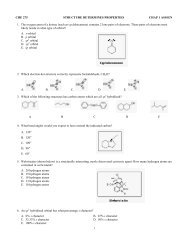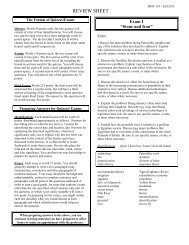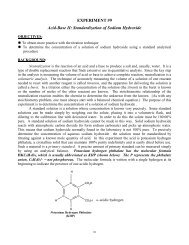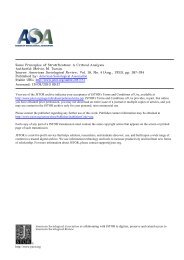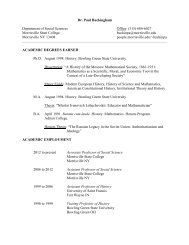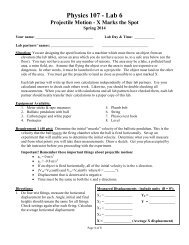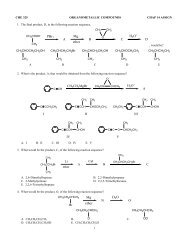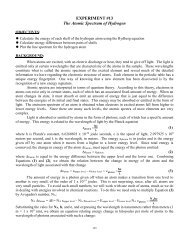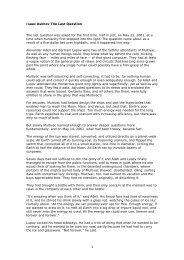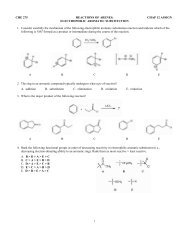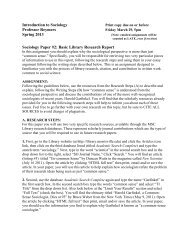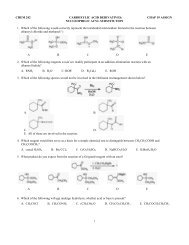The Addition and Resolution of Force Vectors using the Force Table
The Addition and Resolution of Force Vectors using the Force Table
The Addition and Resolution of Force Vectors using the Force Table
Create successful ePaper yourself
Turn your PDF publications into a flip-book with our unique Google optimized e-Paper software.
Page 2 <strong>of</strong> 6<strong>The</strong> <strong>Addition</strong> <strong>and</strong> <strong>Resolution</strong> <strong>of</strong> <strong>Force</strong> <strong>Vectors</strong> <strong>using</strong> <strong>the</strong> <strong>Force</strong> <strong>Table</strong>1.0) Introduction: In this lab, you will use <strong>the</strong> graphical “tip to tail method” to calculate <strong>the</strong> resultantvector coming from <strong>the</strong> addition <strong>of</strong> two or more vectors. <strong>The</strong> resultant vector will also be calculatedma<strong>the</strong>matically by resolving each force vector into its X <strong>and</strong> Y components <strong>and</strong> adding <strong>the</strong>m to get<strong>the</strong> resultant vector.2.0) Equipment:1) Welch force table2) force table pulleys3) force table center ring4) force table center pin5) roll pulley string (length as needed)6) weight hooks, (50 g hook base)7) 100 g weights8) 50 g weights9) assortment <strong>of</strong> additional 100, 50, 20, 10, <strong>and</strong> 5 gram weights10) sheets paper for diagrams11) circular or semi-circular protractor12) cm rule, <strong>and</strong>13) calculator, pencils, <strong>and</strong> loose leaf paper as needed3.0) Procedure:3.0.1) Leveling <strong>of</strong> force table - Check to see <strong>of</strong> your force table is level. Make any neededadjustments by means <strong>of</strong> leveling screws at <strong>the</strong> base <strong>of</strong> <strong>the</strong> table.All force vectors angles will be referenced to <strong>the</strong> right horizontal, or “0 0 St<strong>and</strong>ard PositionAngle” as discussed in lecture. All angles will be measured in a counter-clockwise direction from<strong>the</strong> right horizontal <strong>and</strong> will be assigned a positive angle.3.0.2) Symbology - Any vector which has yet to be resolved into its x <strong>and</strong> y components will belabeled with <strong>the</strong> following notation for <strong>the</strong> magnitude <strong>and</strong> direction <strong>of</strong> <strong>the</strong> vector. A force vector<strong>of</strong> 3920 Newtons pointing 30° above <strong>the</strong> left horizontal, would be represented as:F = 3920 N / 150°In word processing text, a force vector symbol is shown in boldface with <strong>the</strong> st<strong>and</strong>ard positionangle underlined. On h<strong>and</strong>-drawn diagrams or h<strong>and</strong> written analysis you can place a smallarrow above <strong>the</strong> vector symbol to emphasize that it is a vector.Example: F<strong>The</strong> magnitude <strong>of</strong> <strong>the</strong> force exerted by any one hook <strong>and</strong> weight combination will be calculated as:f = ma y = mgwhere, m is <strong>the</strong> mass <strong>of</strong> <strong>the</strong> weights <strong>and</strong> hook in kg (kilograms),g is <strong>the</strong> uniform acceleration constant <strong>of</strong> near-earth, 9.8 m/s 2 , <strong>and</strong>f is <strong>the</strong> force in N, Newtons, or kg-m/s 2 .



